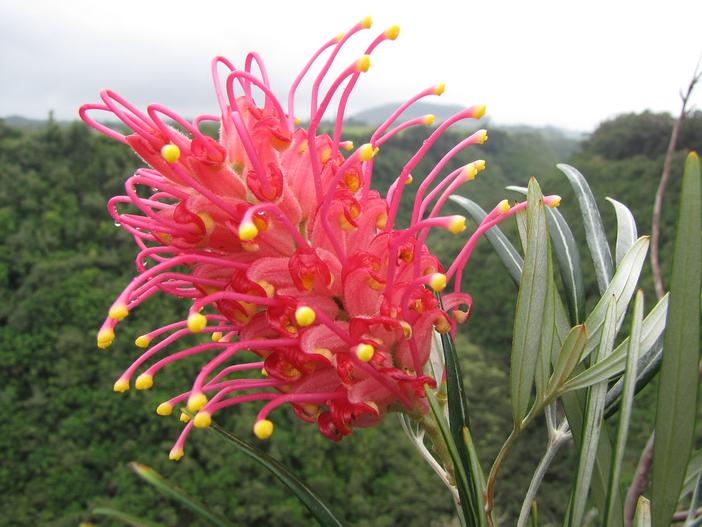Banks’ Grevillea
(Grevillea banksii)
Banks’ Grevillea (Grevillea banksii)
/
/

Forest and Kim Starr
CC BY 2.0
Image By:
Forest and Kim Starr
Recorded By:
Copyright:
CC BY 2.0
Copyright Notice:
Photo by: Forest and Kim Starr | License Type: CC BY 2.0 | License URL: https://creativecommons.org/licenses/by/2.0/ | Uploader: Starr Environmental | Publisher: Flickr


































































Estimated Native Range
Summary
Grevillea banksii, commonly known as Banks’ Grevillea, is an evergreen shrub or slender tree native to coastal Queensland, Australia, particularly found in open forests and coastal scrublands. It can grow as an erect shrub or a slender tree, typically reaching a height of 2–10 m (6 ft 7 in – 32 ft 10 in) with a spread of 2–4 m (6 ft 7 in – 13 ft 1 in). The leaves are deeply divided with four to twelve narrow lobes, presenting a fern-like appearance. Banks’ Grevillea is notable for its striking flowers, which are arranged in cylindrical racemes near the ends of branches and can be creamy-white or bright scarlet to crimson, blooming from August to October. The fruit is a glabrous follicle 15–25 mm long.
Banks’ Grevillea is valued for its vibrant flowers and ability to attract nectar-feeding birds, making it a popular choice for wildlife gardens. It is used in cultivation for hedges, screens, and as a specimen plant in gardens with ample space. This species prefers well-drained soils, tolerates poor soils, and requires full sun to light shade. It is relatively drought-tolerant once established but benefits from occasional watering during prolonged dry periods. While generally low-maintenance, it can be susceptible to root rot in poorly drained soils. In regions outside its native habitat, it is important to check for potential invasiveness before planting.CC BY-SA 4.0
Banks’ Grevillea is valued for its vibrant flowers and ability to attract nectar-feeding birds, making it a popular choice for wildlife gardens. It is used in cultivation for hedges, screens, and as a specimen plant in gardens with ample space. This species prefers well-drained soils, tolerates poor soils, and requires full sun to light shade. It is relatively drought-tolerant once established but benefits from occasional watering during prolonged dry periods. While generally low-maintenance, it can be susceptible to root rot in poorly drained soils. In regions outside its native habitat, it is important to check for potential invasiveness before planting.CC BY-SA 4.0
Plant Description
- Plant Type: Shrub
- Height: 8-12 feet
- Width: 5-6 feet
- Growth Rate: Rapid
- Flower Color: Pink, Red
- Flowering Season: Spring, Summer
- Leaf Retention: Evergreen
Growth Requirements
- Sun: Full Sun
- Water: Medium
- Drainage: Medium
Common Uses
Bee Garden, Bird Garden, Butterfly Garden, Deer Resistant, Drought Tolerant, Hummingbird Garden, Low Maintenance, Showy Flowers, Street Planting
Natural Habitat
Native to coastal Queensland, particularly in open forests and coastal scrublands
Other Names
Common Names: Kahili Flower, Forster’s Grevillea, Dwarf Silky Oak, Red Silky-Oak, Banks’s Grevillea, Byfield Waratah, Red Flowered Silky Oak, Kahili-Flower
Scientific Names: , Grevillea banksii, Grevillea forsteri, Grevillea bancksii, Grevillea banksii f. albiflora, Grevillea banksii var. forsteri, Grevillea hanksii f. albiflora, Grevillea robusta var. forsteri, Hakea banksii, Stylurus banksii
GBIF Accepted Name: Grevillea banksii R.Br.